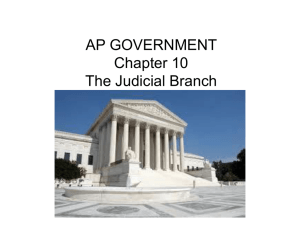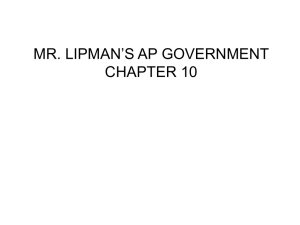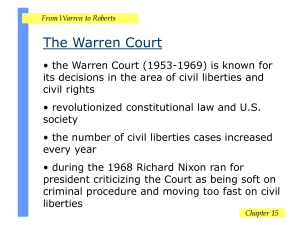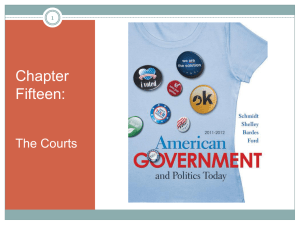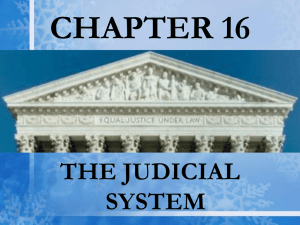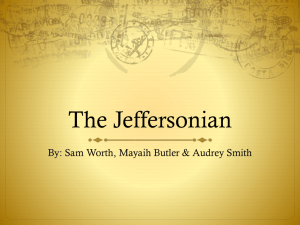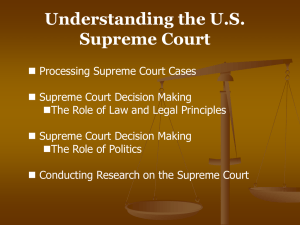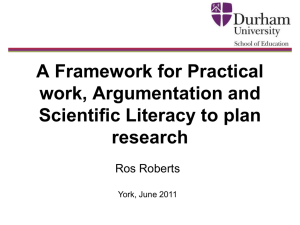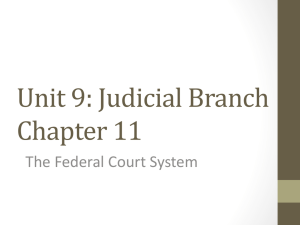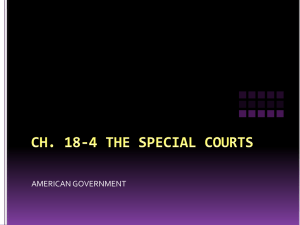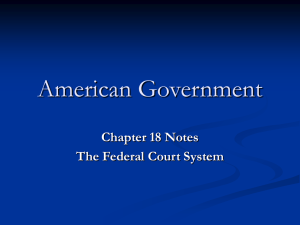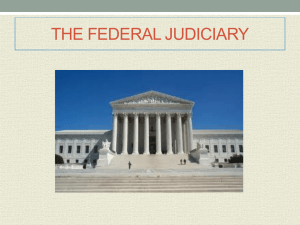PPT - McCormick Foundation
advertisement
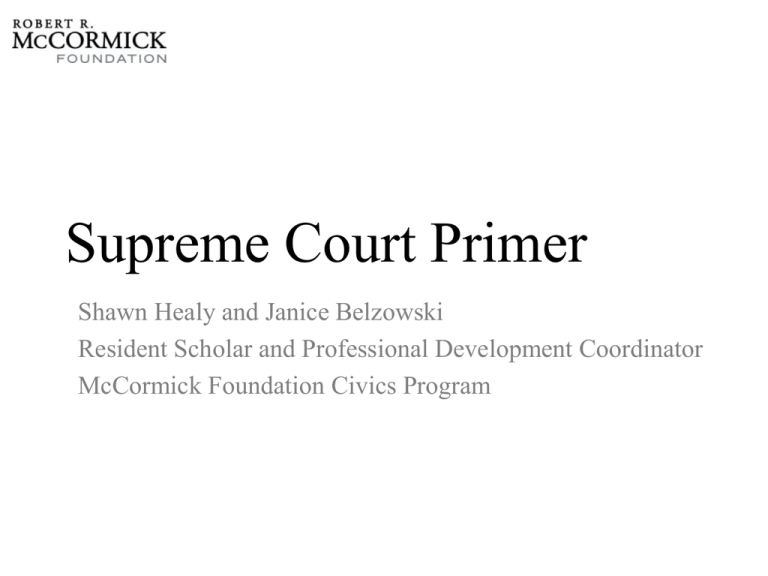
Supreme Court Primer Shawn Healy and Janice Belzowski Resident Scholar and Professional Development Coordinator McCormick Foundation Civics Program Overview: Supreme Court Primer 1. Constitutional underpinnings 2. Judicial review 3. Flow of cases to the U.S. Supreme Court 4. Case selection and oral arguments 5. Decisions and opinions 6. Meet the Roberts Court Constitutional Underpinnings Article III, Section 1: 1. Judicial power bestowed upon Supreme Court 2. Congress tasked with establishing lower federal courts 3. Federal judges hold lifetime terms during “good behavior” Article III, Section 2: 1. Original jurisdiction: Cases affecting ambassadors or when the state is a party 2. Appellate jurisdiction: Admiralty and marine jurisdiction, where the U.S. is a party, controversies between two or more states, between citizens of different states, and between states and citizens or citizens and foreign states or citizens -Discretionary as of 1988 Constitutional Underpinnings Federalist 78: • • • • Judiciary as “least dangerous branch”: “…No influence over either the sword or the purse, no direction either of the strength or of the wealth of the society, and can take no resolution whatever.” Lifetime appointments an “…excellent barrier to the encroachments and oppressions of the representative body” as a means of “secur(ing) a steady, upright, and partial administration of laws.” Judges a rare breed: “…That the record of those precedents must unavoidably swell to a very considerable bulk, and must demand long and laborious study to acquire a competent knowledge of them. Hence it is there can be but few men in the society, who will have sufficient skill in the laws to qualify them for the station of judges.” Seeds of judicial review: Limited constitution maintained “through the medium of the courts of justice; whose duty it must be to declare all acts contrary to the manifest tenor of the constitution void.” Constitutional Underpinnings Federalist 80: • Why a Supreme Court? “The mere necessity of uniformity in the interpretation of the national laws, decides the question. Thirteen independent courts of final jurisdiction over the same causes, arising upon the same laws, is a hydra in government, from which nothing but contradiction and confusion can proceed.” Federalist 81: • The role of the lower courts: “…Calculated to obviate the necessity of having recourse to the supreme court, in every case of federal cognizance. It is intended to enable the national government to institute or authorize in each state or district of the United States, a tribunal component to the determination of matters of national jurisdiction within its limits.” Constitutional Underpinnings Judicial appointments a shared power between the President and the Senate • • • • • The President nominates and a majority of the Senate confirms Whereas geographic and religious factors formerly affected appointments, race and gender now predominate Ideology and professional qualifications are most important in the confirmation process Historically the Senate rejected 1/6 of nominees, but only 5 in total in the 20th Century, and most nominees received at least a 2/3 vote Other factors: -President’s political strength (place in term, approval ratings) -Interest group mobilization -Perceived impact of nominee on the ideological balance of the Court Constitutional Underpinnings Judicial qualifications • • • • Every justice has entered with some form of legal training Most have held high positions in government or held in esteem at the academy Recently, appellate court membership seems significant -Established record on positions important to the President -Proof nominee can survive Senate scrutiny -Personal history vetted to some degree Historically, all but 12 nominees belonged to the same party as the President -Ideological conformity not guaranteed, but a more exact science nowadays Constitutional Underpinnings Number of Justices 12 10 10 9 9 9 8 7 6 6 7 6 5 4 2 0 1789 1801 1802 1807 1828 1863 1866 1869 2011 Number of Justices Judicial Review Marbury v. Madison (1803): • • • William Marbury denied appointment as justice of the peace in the District of Columbia by the incoming presidential administration, files suit Question: Is Marbury entitled to his appointment? Is his lawsuit the correct way to get it? And, is the Supreme Court the place for Marbury to get the relief he requests? Decision: Yes; yes; and it depends. The justices held, through Marshall's forceful argument, that on the last issue the Constitution was "the fundamental and paramount law of the nation" and that "an act of the legislature repugnant to the constitution is void." In other words, when the Constitution--the nation's highest law--conflicts with an act of the legislature, that act is invalid. This case establishes the Supreme Court's power of judicial review. Judicial Review Requires actual case and controversy (standing): • • • • See Newdow v. U.S. Congress, Elk Grove Unified School District (2004) Some laws may be challenged on facial grounds, meaning they are unconstitutional as constructed Others are subject to as applied challenges, meaning they are unconstitutional in application See Crawford v. Marion County Election Board (2008) Judicial Review Incorporation of the Bill of Rights: • Process of applying portions of the Bill of Rights deemed within the realm of liberty protected by the Due Process Clause of the 14th Amendment to state and local laws – • Amendment 14, Section 1: All persons born or naturalized in the United States, and subject to the jurisdiction thereof, are citizens of the United States and of the state wherein they reside. No state shall make or enforce any law which shall abridge the privileges or immunities of citizens of the United States; nor shall any state deprive any person of life, liberty, or property, without due process of law; nor deny to any person within its jurisdiction the equal protection of the laws. Orchestrated selectively: To date, excludes the 3rd and 7th Amendments, along with the grand jury clause of the 5th Amendment, and the right against excessive bail and fines of the8th Amendment The First Amendment has been incorporated in total • – – – – Speech (Gitlow v. NY, 1925) Press (Near v. Minnesota, 1931) Assembly and petition (De Jonge v. Oregon, 1937) Religion: Establishment Clause (Everson v. Board of Education, 1947) Judicial Review Constitutional law: • Build over time through adherence to past precedent, or stare decisis. • Justices are apt to voice their adherence to stare decisis, but may discard it in practice – – – • It is here that the debate between originalism and a living Constitution lies Judicial restraint as a prevailing norm Both sides are arguably guilty of their own brand of “judicial activism” The body of constitutional law is generally evolutionary, not revolutionary – – – Resolving intercircuit conflicts Considering bold new executive or legislative initiatives Court starts a fire of its own Flow of Cases to the SCOTUS Federal • Court of Appeals (in DC and 11 numbered districts) – • Feeders: Districts courts, independent commissions and regulatory agencies, and tax courts Court of Appeals for the Federal Circuit – • Feeders: Court of Claims and Court of International Trade Court of Appeals for the Armed Forces – • Feeder: Lower military courts Foreign Intelligence Surveillance Court of Review – Feeder: Foreign Intelligence Surveillance Court State: Trial courts to intermediate appellate courts to state supreme courts Case Selection and Oral Arguments 1. Petition for Supreme Court consideration via a writ of certiorari -Cases involve two parties, at least one of them initiating the contest -May involve individual rights or seek affirmation of policies -Interest groups play a significant role, representing economic, demographic, or ideological groups, and also the government itself 2. Supreme Court “grants cert” and agrees to hear a case -Requires support of at least four justices -Roughly 1% of cases accepted for consideration: Civil liberties, statutory interpretation, economic issues, and federalism predominate -Court seeks cases where an issue remains unresolved, there is intercircuit conflict, or there is evidence of malpractice among lower courts 3. Friend of the Court briefs, or amicus curiae, are solicited and accepted 4. Oral arguments -Each side is permitted 30 minutes to present case -Justices pepper counsel with questions intermittently Decisions and Opinions 1. While in session, justices conference weekly to select cases and assign opinions -Justices speak in order of seniority, and cast their preliminary votes -If the Chief Justice is in the majority, s/he assigns the opinion - If the Chief Justice is in the minority, the most senior justice in the majority assigns the opinion 2. Majority and dissenting opinions are later circulated -May hold a majority together, craft a new one, or expand an existing one—verbal jousting rare -Other justices are asked to sign on to these respective opinions -In the process, signees may end up shaping the final product -The principles of unity and minimal winning coalitions compete against one another 3. When the majority speaks with one voice and the opinion is unsigned, the decision is called per curiam Decisions and Opinions (Continued) 4. Justices may write concurring opinions to expound upon the consensus sentiments -They may also distinguish between the outcome of the case and the reasoning behind the respective opinions 5. Dissenting opinions are important because they may forecast the future direction of the Court -Holmes and Brandeis set the stage for future First Amendment jurisprudence in a series of early 20th Century dissents concerning free speech cases 6. The SCOTUS reverses roughly 2/3 of the lower court decisions it reviews -Court rarely strikes down congressional statutes: Often minor laws or relics of the past -State statutes more frequently overturned -Presidents not immune from scrutiny: See Lincoln, Truman and Bush Decisions and Opinions (Continued) 7. Decisions address two aspects of the case: the parties themselves and the larger consequences of the ruling 8. Implementation: -Relies upon: A. Communication of set policies to government officials -Plays out in lower courts where ambiguity allows leeway for judges to pursue their own policy goals B. Willingness of them to obey accordingly C. Ability of the Court to sanction noncompliance -Reversal of lower court decisions one mechanism -Assisted by interest groups who file suit when they see instances of noncompliance Meet the Roberts Court How well do you know your Supreme Court? Meet the Roberts Court Meet the Roberts Court Catholic Jewish Meet the Roberts Court T or F? In a typical term the Court decides more cases 5-4 than 9-0. FALSE. In a typical term, the Court issues more unanimous decisions than 5-4 decisions. Meet the Roberts Court Cases by Vote Split (October Term 2010) 9-0 8-1 7-2 6-3 38 (48%) 10 (13%) 12 (15%) 5-4 4 (5%) 16 (20%) Past Terms 9-0 8-1 7-2 6-3 5-4 OT09 46% 10% 15% 11% 18% OT08 33% 5% 16% 16% 29% OT07 30% 9% 29% 14% 17% OT06 39% 13% 11% 4% 33% OT05 56% 5% 11% 16% 12% Avg. 41% 8% 17% 12% 22% *Data from SCOTUSblog Stat Pack www.scotusblog.com Meet the Roberts Court Typically, which justices tend to be considered most “conservative”? Roberts, Alito, Scalia and Thomas Meet the Roberts Court Typically, which justices tend to be considered most “liberal”? Ginsberg, Breyer, Sotomayor, and Kagan Meet the Roberts Court Which leaves _________ as the “swing” voter. Kennedy Meet the Roberts Court •Kennedy was in the majority 94% of the time in OT10 •What else do you notice about this graph?? •Conservative majority (and Kennedy) are more frequently in the majority than the Courts liberal leaning Justices •Also note that Justice Kagan only participated in 53 cases, meaning she recused herself 27 times this term. *Data from SCOTUSblog Stat Pack www.scotusblog.com Meet the Roberts Court Composition of 5-4 majorities *Data from SCOTUSblog Stat Pack www.scotusblog.com Meet the Roberts Court Approximately how many cases are appealed to the U.S. Supreme Court each year? Approx. 8000 petitions for certiorari each term Approximately how many are accepted for briefing and oral argument? For the past few terms the Court has averaged about 75 decisions per term, so less than 1% of cases are accepted. Meet the Roberts Court This year, 82 total merits opinions were released …Signed opinions after oral argument …Summary reversals …Affirmed 4-4 75 5 2 (A summary reversal is a case in which the Supreme Court grants a petition for certiorari and reverses the lower court judgment without further briefing or argument, usually through an unsigned opinion) Meet the Roberts Court T or F? When the SC decides not to hear a case (denies certiorari) it is saying that it agrees with the lower court opinion and that the lower court decision should become a precedent. False. When certiorari is not granted, no precedent is set. The decision below simply stands. Meet the Roberts Court Which court system generates most of the cases accepted by the U.S. Supreme Court – state or federal? Federal Courts - specifically the federal courts of appeal Meet the Roberts Court T or F? Most experts who study the Court believe that the primary reason the Court decides to hear a case is to correct a legal error made by a court below. False. The primary reason the Court decides to hear a case is to resolve a conflict between the lower courts as to the resolution of a particular legal question. Meet the Roberts Court •In the OT2010 24 cases were affirmed which is only about 30%. •So, 70% of the time, they reverse the decision of the lower court. Meet the Roberts Court A look ahead… • OT2011 – 41 cases on the docket • FCC v. Fox Supreme Court Primer Questions?
